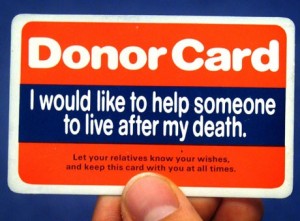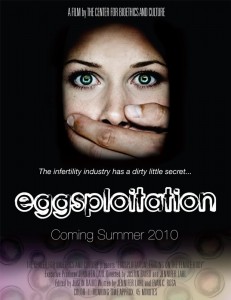Young Women Exploited by Fertility Industry
Why Is Selling Eggs an Exception to Law?
Catholic teaching is consistent and clear. The sale of human organs and tissues is immoral because it demeans human dignity and regards the human person as a commodity. John Paul II addressed the subject in a speech to the 18th International Congress of the Transplantation Society in August, 2000:
“It must first be emphasized … that every organ transplant has its source in a decision of great ethical value: ‘the decision to offer without reward a part of one’s own body for the health and well-being of another person’… Accordingly, any procedure which tends to commercialize human organs or to consider them as items of exchange or trade must be considered morally unacceptable, because to use the body as an ‘object’ is to violate the dignity of the human person.
 Fortunately, most of the world’s civil law agrees with Catholic teaching and bans the sale of human organs. In the United States, this principle was codified in the 1984 National Organ Transplantation Act (NOTA), which specifically outlawed the commercialization of human organs and tissues:
Fortunately, most of the world’s civil law agrees with Catholic teaching and bans the sale of human organs. In the United States, this principle was codified in the 1984 National Organ Transplantation Act (NOTA), which specifically outlawed the commercialization of human organs and tissues:
SEC.301. (a) It shall be unlawful for any person to knowingly acquire, receive, or otherwise transfer any human organ for valuable consideration for use in human transplantation if the transfer affects interstate commerce.
An interesting twist in the enforcement of this act developed in December 2011. The US Court of Appeals for the Ninth Circuit ruled that while sale of bone marrow was specifically banned in the 1984 NOTA , a new bone marrow procurement procedure known as apheresis could remove this restriction. Apheresis allows for the collection of marrow stem cells in a process akin to routine blood donation rather than requiring the painful insertion of a large bore needle directly into the marrow cavity to aspirate bone marrow. NOTA did not ban the sale of blood products, like plasma. It was the judgment of the court that the procurement process for bone marrow no longer carried a significant burden or risk for the donor, so there was no longer a reason to ban its sale if obtained via apheresis. Bone marrow obtained by the older aspiration method still cannot be sold.
NOTA anticipated the likely advancement of technology and made allowances for the Secretary of Health and Human Services to ban the sale of additional organs and tissue as needed. In this ruling, however, the judges reasoned that Congress could not have foreseen the development of apheresis. They essentially argued that this technological development nulls the original justification for banning the sale of bone marrow.
Using the logic of this ruling, it seems the converse should also be true: a human tissue whose procurement imposes a great risk and burden to the donor should be included in the NOTA ban on sales of human organs. So why does the United States allow the unfettered commerce in oocytes, commonly called “human eggs?”
In 1984 Congress could not have foreseen the explosion of the fertility industry. The first child born through in vitro fertilization (IVF) technology was only six years old. Since then, however, technological advances that enabled the routine use of IVF have also produced an exploitive and dangerous worldwide trade in human eggs. Just as new technology justifies the exemption of bone marrow from the restrictions of NOTA, new technology justifies the addition of human eggs to the list of organs and tissues banned for sale.
Procurement of human eggs for in vitro fertilization poses far more risk and burden to the donor than does the original technique for obtaining bone marrow. Women are subjected to a series of injections with powerful hormones to stimulate the maturation of dozens of eggs in their ovaries, instead of the usual one or two. The regimen carries the risk of ovarian hyperstimulation syndrome — fluid imbalances, respiratory distress, stroke, and death. If a woman survives the generation of multiple mature eggs, she must then undergo surgery under anesthesia to retrieve the eggs. This imposes all the risks inherent to any surgery, including adverse reactions to anesthesia, infections, damage to adjacent organs, excessive blood loss, and death. In addition, the ovary can be so damaged during the retrieval process that it must be subsequently removed, putting at risk a woman’s future fertility.
Given these catastrophic possibilities, why would any woman agree to be an egg donor? Most likely, the answers have to do with money and ignorance. The term “egg donor” is actually a misnomer: To donate implies a freely-given gift. A more accurate term would be “egg supplier.”
The multi-billion dollar fertility industry is largely unregulated, and the demand for human eggs is huge. Check college campus newspapers and you will likely find advertisements offering tens of thousands of dollars for the donation of oocytes. The fertility clinics prey upon this population of young women who are likely to be seeking cash due to educational expenses. The ads present it as a simple process with the altruistic benefit of helping an infertile couple achieve the dream of a having a child. It is a win-win proposition. The donor relieves her financial worries and a happy family is created using her eggs to manufacture an embryo. There is scant mention of health risks.
 The screening process begins the dehumanization of the egg supplier. Infertile couples specify the ethnicity, height, weight, IQ, test scores, and medical history desired in their egg supplier. A potential oocyte supplier is evaluated like a farm animal against these criteria and matched with a buyer. It is ironic that many of these buyers probably seek hormone-free meat and eggs for their dinner table yet have no compunction about treating a woman like an industrial farm chicken and pumping her full of hormones to make her produce more eggs.
The screening process begins the dehumanization of the egg supplier. Infertile couples specify the ethnicity, height, weight, IQ, test scores, and medical history desired in their egg supplier. A potential oocyte supplier is evaluated like a farm animal against these criteria and matched with a buyer. It is ironic that many of these buyers probably seek hormone-free meat and eggs for their dinner table yet have no compunction about treating a woman like an industrial farm chicken and pumping her full of hormones to make her produce more eggs.
Further illustrating the lack of regard for the woman supplying eggs is the failure to provide adequate information for fully-informed consent. The medical risks outlined above are the known short-term risks, however, what are the long-term consequences to egg donation? There are anecdotal reports of breast cancer in women who have undergone ovarian stimulation and subsequent harvesting of eggs. As outlined in the documentary Eggsploitation, there are no scientifically rigorous studies to elucidate any remote effects. Egg suppliers are paid and forgotten. They receive no medical follow-up to assess complications related to their egg donation. A truthful informed consent form would clearly state that the long-term effects have not been studied, and therefore cannot be stated with any degree of certainty.
Not only do the fertility clinics fail to outline all the medical risks, but they also fail to accurately reveal how the eggs will be used. The Dec. 26, 2011, issue of Fertility and Sterility included a study that evaluated the consent forms for fertility clinics that supplied embryos for research. Only 30% of these clinics stated in the consent form that embryos created from the supplied eggs would be used for research. Of those that mentioned the embryos could be used for research, only a handful specified that they would be used for embryonic stem cell research. Again, there is a total lack of concern for the woman supplying eggs for IVF. The process is portrayed as a generous gift to an infertile couple, when in actuality it may be part of morally objectionable research.
Clearly, based on the risks of harvesting oocytes, the coercive nature of large sums of money paid for human eggs, and the lack of regard for the physical and emotional well-being of the women providing the eggs, the commercial trade in oocytes by the fertility industry is both exploitive and dangerous. Many countries acknowledge this and apply at least some regulation to the procurement and sale of human eggs. In Israel it is illegal to harvest oocytes for IVF except for a woman’s own personal use. Most European Union countries ban payments for donor eggs while allowing compensation for associated costs and lost wages. This murky distinction between compensation and payment has provided only a modicum of protection against coercive recruitment of egg suppliers. In 2007, the United Kingdom outlawed virtually all compensation for providing oocytes. Spain and Cyprus are the two European countries that have resisted such regulations. They have become prime destinations for medical tourists seeking IVF. The donors in these countries are often poor immigrants who sell their eggs at a fraction of the price paid in the United States.
The secretary of HHS has the legal means under NOTA to stop the wanton profiteering of the fertility industry at the expense of young women. The reckless disregard for the health and well-being of the egg suppliers demonstrates the moral imperative for such a move, while the decision by the Ninth Circuit Court of Appeals gives legal justification for such action. The intent of the 1984 National Organ Transplant Act was to prevent exactly this kind of exploitation. If HHS will not protect American women from this travesty, then Congress must act to stop the fertility industry’s commodification and endangerment of women.

